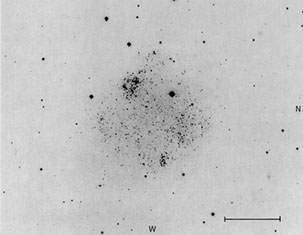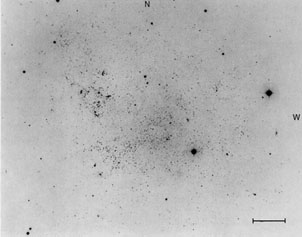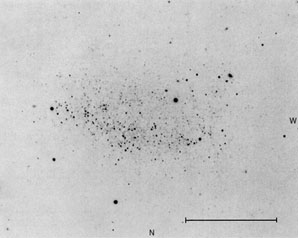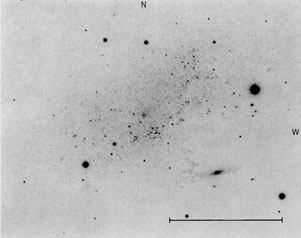


Galaxies of this type are highly resolved into Population I supergiants. The surface brightness is even lower than for galaxies of class IV-V.
None of the galaxies shown here are in the RSA. Their surface brightness is too low despite the fact that in some cases their integrated apparent magnitude is brighter than the SA limit.
Cepheids have been found, of course, in IC 1613 by Baade and now in Sextans A and Leo A. The background sheet of old red stars that starts at MV = - 3m has been found in IC 1613 and Sextans A, and perhaps in Leo A and the Pegasus Dwarf.
We consider these systems, except Ho I
and Ho IX,
to be in or very
near the Local Group. These two galaxies are in the M81 /
NGC
2403
group. Ho IX is the dwarf companion to M81,
near to the main body on
the north side. It resolves into fainter blue supergiants than M81
itself (as is expected from the correlation of the brightness of the
blue supergiants with that of the parent galaxy), but the red
supergiants resolve at V
 20, which is consistent with
MV = -8m.0 ± 0m.1
for these stars independent of the parent's luminosity
(Sandage and Tammann, 1974c).
Galaxies of this type and luminosity class are
expected to provide improved calibration of the absolute magnitude of
the brightest resolved stars as distance indicators.
20, which is consistent with
MV = -8m.0 ± 0m.1
for these stars independent of the parent's luminosity
(Sandage and Tammann, 1974c).
Galaxies of this type and luminosity class are
expected to provide improved calibration of the absolute magnitude of
the brightest resolved stars as distance indicators.

Sextans A P200-90-MH ImV (-15m.2)L | 
IC 1613 P200-869-B ImV -14m.59L |

Ho I P200-5470-S ImV -14m.40N | 
Ho IX P200-7140-S ImV -13m.54N |

Leo A P200-95-S ImV (-13m.1)L | 
Peg Dwarf P200-7288-S ImV (-11m.5)L |